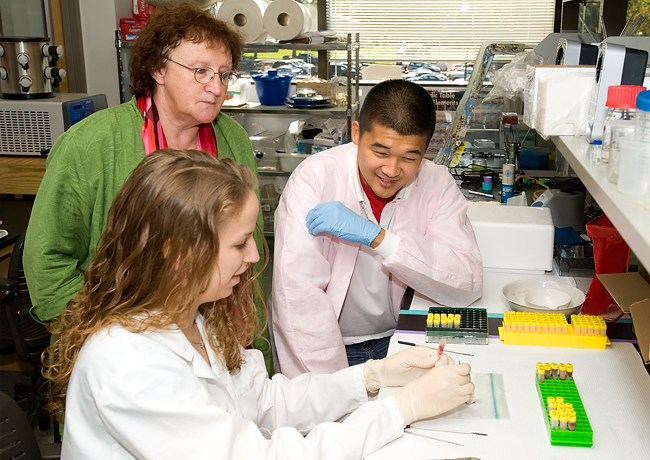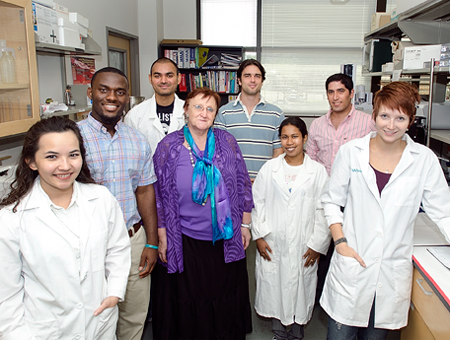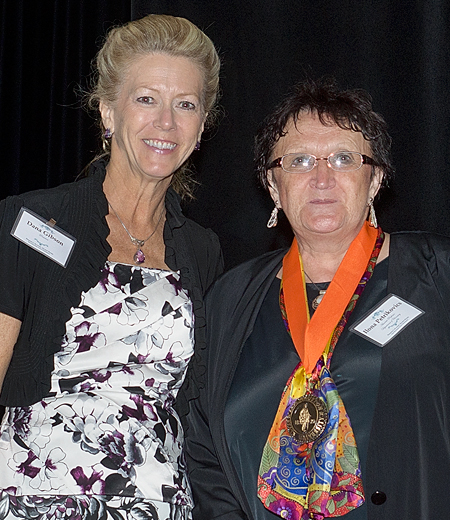'Excellent' Researcher Works To 'Save Lives By The Minute'
Sept. 30, 2013
SHSU Media Contact: Jennifer Gauntt
Story By: Meredith Mohr
 |
| Though her research literally could impact millions of people (and won her SHSU's Excellence in Research Award for 2013), associate professor of chemistry Ilona Petrikovics's work with the dozen students who help in her lab is among her proudest. —Photos by Brian Blalock |
Though she spends a lot of time in the classroom, Sam Houston State University associate professor of chemistry Ilona Petrikovics is always hard at work in the lab.
Clad in a white lab coat, she eyes a rack of delicate test tubes, quickly jotting down information in a lab book propped on the table. Bottles and beakers with colored liquid and carefully labeled research material may look like a regular day in chemistry lab.
Petrikovics, with the help of several of her students, is investigating better methods to deliver life-saving antidotes to those exposed to cyanide. Her work, if successful, could save the lives of soldiers, military personnel and civilians alike.
But there’s something else about this research that makes it distinctly important. This toxicology research is conducted following an aggressive schedule of deadlines and deliverables, set by Petrikovics and her team in collaboration with the U.S. Army and the National Institute of Health. Deliverables are specific research tasks that have associated deadlines, used to measure the quality of the research by how many of these tasks are completed by their deadlines.
This schedule of deliverables helps to ensure that the search for a better “agent to antagonize cyanide intoxication” will succeed; as she puts it, “we are helping to save lives by the minute.”
As of right now, the potentially life-saving drug is in the development process and could be close to the patenting and clinical testing stage of the best cyanide countermeasure combinations, Petrikovics said.
Cyanide, an especially lethal indoor chemical weapon, is the second most common cause of smoke inhalation fatalities in fires, after carbon monoxide.
Assistant professor of chemistry David Thompson, who collaborates with Petrikovics on experimentation and analysis of other aspects of the cyanide research program, said that the reason for their research is to “help soldiers exposed to cyanide as a chemical weapon, or to cyanide as a component of smoke in battleground fires.”
“When cyanide, a deadly chemical, enters the bloodstream, it prevents the cells from utilizing oxygen and prevents them from being able to obtain the energy needed for life,” Petrikovics said. “The oxygen sits unused in the body. This unused oxygen alters the color of the blood to cherry red in both veins and arteries. Since the cyanide prevents the cells from accessing oxygen, and thus energy, the body shuts down. Our research is to develop improved therapeutic, counteractive drugs to offset the effects of cyanide poisoning.”
Her team for this work includes researchers from the University of California, San Diego; Harvard; University of Irvine, California; South Dakota State University; the University of Minnesota; and the U.S. Army Medical Research Institute of Chemical Defense.
Perikovic’s journey to SHSU and her work with the military began in Hungary, where she grew up.
"Conducting research at an academic institute without involving students would be like trying to play a symphony on a single instrument.” —Ilona Petrikovics |
 |
| Petrikovics says she takes on a "mother figure" and mentor role with her approximately 14 undergraduate and graduate students who work with her in her lab each semester. Her work with students allows her to combine a passion for research, teaching and an expertise in her field. |
Petrikovics holds two doctorates, one in medicinal biology from University Medical School in Debrecen in Hungary and one in organic chemistry (with a minor in biochemistry), as well as a master’s degree in general chemistry from the L. Kossuth University of Arts and Sciences in Debrecen, Hungary.
Her first big leap of faith came when she left Hungary in 1990, following personal financial hardship and a divorce, to start over in the United States in the post-doctoral job field. It was one of many big adventures.
“With nothing else I could do and a 5-year-old son and $50 in my pocket, I came to America. In retrospect, I sometimes ask myself, ‘how did I dare do this?’ But we made it,” Petrikovics said. “I spent 12 years at Texas A&M in the field of chemical warfare agent antagonism. My son was a nationally recognized top student at school and continued his career at Microsoft as a program developer.”
She received a National Research Council Fellowship with the U.S. Army Medical Research Institute of Chemical Defense in Maryland and left Texas for Baltimore. But after much snow and missing home, she accepted several other jobs before settling at SHSU, searching for a way to stay where her heart was “at home in Texas,” she said.
And though her family had grown up and moved on, Petrikovics discovered a new family—one right in her lab at SHSU.
Her research with the Army while at SHSU is made possible by a grant funded by the National Institute of Health and the USAMRICD. This way, she is able to continue her research and include student help on projects, which greatly furthers their lab experience; it is the combination of passion for research and teaching and expertise in the field that she applies to her work, she said.
“Life did not stop,” Petrikovics said. “I found the other love in my life. Here at SHSU I had many students to work with, and I got to work on two of my favorite projects in the field I knew I was supposed to be in. I feel that combining research with students is just a top level of joyous activities in my life.
“I consider academic research as a special form of teaching. Conducting research at an academic institute without involving students would be like trying to play a symphony on a single instrument.”
Her students participate in a range of national and international scientific meetings, build contacts and co-author her peer-reviewed publications.
Several of her students have received the prestigious national Pfizer Award and others have gone on to do toxicology/medical sciences research at prestigious universities and institutions, such as Katelyn Stafford, who is now in the toxicology program at Johns Hopkins University.
“It is such a great opportunity for my students to be able to work on research like this in the lab right here on campus. I can’t emphasize that enough,” Petrikovics said.
“And I am lucky too, because even though it is difficult when a student is only here for a short period of time and graduates or leaves just when they are really getting involved in the research, I have had some incredibly gifted and amazing students working in my lab,” she said. “They have gone on to do great things in the field of chemistry-related research and I am proud of them. I just wish I could hire them all to stay here.”
Petrikovics said that each year, she has an average of 14 undergraduate and graduate students in her lab working with her. In this environment, though they are working side by side, she acts as a mother figure and a mentor. As projects progress, she said she notices when a student is particularly “highlighted” in their work with her.
 |
| Petrikovics was recognized by university President Dana Gibson at the beginning of the semester as the 2013 Excellence in Research award winner during the annual academic awards dinner, which recognizes faculty who have made great achievements in the past academic year. |
“There are always a few standouts, my most enthusiastic students. This year I consider Anna Duke as the top undergraduate,” Petrikovics said. “I also try to give additional energy to those who are just about to leave the nest, even as I continue to mentor those who have many more years with me ‘at home.’ Everything is moving ahead.”
Duke, who began working with Petrikovics when she received the Welch Summer Research Scholarship, said that her work in the lab—which includes everything from planning and organizing all aspects of the research, sample analysis, preparation of samples and responsibility for records and instruments—has opened many doors for her.
“I have publications coming out, which is uncommon for an undergraduate student and looks very good on an application. Just the fact that I work on a confidential NIH and Army-funded project is impressive to graduate schools,” Duke said. “I have recently gotten into the chemistry program at University of Houston, and I give a huge chunk of the credit to Dr. Petrikovics and the opportunities she has given me through this project.
“Graduate programs are very impressed if a person extensively participates in research, and she has given me the opportunity to do exactly that,” Duke said. “I recommend every chemistry student to get involved in research with a professor as early as possible and be as involved as they can possibly be.”
For Petrikovics, life is moving at a rapid pace with teaching classes, working with a laboratory student team and continuing her research that could have significant long-term meaning for the bio-medical chemistry field.
For now, besides seeing her students graduate or move on successfully, her goal is to come up with the best product at the pre-clinical research level of the drug discovery and development process by the end of 2014.
But whether her cyanide antagonists find widespread use or not, she said she is happy to be a part of a bigger goal.
“My future plan is to further participate in this research up to the final point of the clinical trial and even further, developing efficient therapeutic agents to protect soldiers and civilians from cyanide intoxication,” Petrikovics said. “I always think about those hard efforts and results of my group that we achieved ahead of others in the field, and it basically does not matter who gets the profit from the production, since the major profit comes from providing healing to those who are sick.
“Regardless of who gets the patent, we will always know that we have made a strong contribution to this national effort, and the real profit from these efforts will be derived by those whose lives will be protected.”
- END -
This page maintained by SHSU's Communications Office
Associate Director: Julia May
Manager: Jennifer Gauntt
Located in the 115 Administration Building
Telephone: 936.294.1836; Fax: 936.294.1834
Please send comments, corrections, news tips to Today@Sam.edu.

 SamWeb
SamWeb My Sam
My Sam E-mail
E-mail

